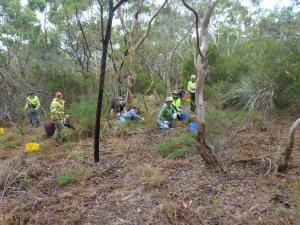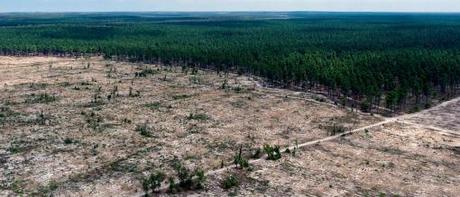
As I have discussed before, the greatest threatening process to biodiversity in South Australia today is past and ongoing clearing of native vegetation. So, arresting further vegetation clearing, and restoring previously cleared land to functional native-vegetation communities are easily the highest priorities across the entire State.
Despite some valiant attempts across South Australia to revegetate previously cleared areas1, the haphazard approach to reforestation in South Australia means that we are unlikely to be maximising ecological function and providing the best habitats for native biodiversity. Several improvements in this regard can be made:
(i) Establish a State Register of past, ongoing, and planned revegetation projects, including data on the proponents, area revegetated, species planted, number of individuals planted for each species, monitoring in place (e.g., plant survival, other species using the restored habitat, etc.), and costs (actual or projected). Such a State Register would allow for a more regional coordination of future revegetation projects to suggest potentially more ecologically useful approaches. This could include identifying the most locally suitable species to plant, maximising the area of existing native habitat or restored fragments by planting adjacent to these, joining isolated islands of habitat to increase connectivity, or even to create more efficient projects by combining otherwise independent proponents (e.g., adjacent landholders).
(ii) Establish a State Revegetation Council that uses data from the Register to prioritise projects, enhance collaboration, and suggest improvements in design and placement according to the principles mentioned above. The Council could also help to coordinate monitoring of progress and ecological outcomes at the landscape scale. A similar State Register for Wetland Restoration and a relevant Council could be established in a similar manner, emphasising the conservation and restoration of smaller wetlands with more unique, endemic plant species. Likewise, both Councils could ideally assist in coordinating non-profit and private organisations in terms of their revegetation priorities, as well as coordinate with conservation covenants(see below) for private landholders.
Perhaps the best example of a large-scale project to enhance habitat connectivity in Australia is the ambitious (yet, so far incomplete) Gondwana Link, which is attempting to link fragments of bushland together into a contiguous habitat feature. Operating in southern Western Australia, the program is aiming to achieve complete forest connectivity over about 1000 km, from the dry woodlands of the interior, to the tall, wet forests of the far south-west corner of that State. By restoring the native vegetation in the gaps between forest fragments, the overall aim is to build a contiguous forest over this entire range.
Given that connectivity is an important feature of habitats that improve the conservation prospects of the many species living within them by allowing species to move freely among populations, and by increasing the overall size of the available habitat, Gondwana Link represents, if fully realised, one of the greatest potential conservation achievements in Australia’s history. South Australia used to have an analogous program known as NatureLinks, from which successful projects like Bounceback emerged. However, Commonwealth and State funding for the program dried up several years ago, and it is unfortunately no longer planned. A return to a NatureLinks-like program would achieve many conservation gains for the State of South Australia.

(iii) Most revegetation projects in South Australia are not specifically linked to particular conservation outcomes. Thus, establishing what specific goals the revegetation intends to have (e.g., expanding the available habitat for specific species) will help design projects of sufficient magnitude and composition for the intended outcomes. As far as is practical, approaches should therefore follow the National Standards for the Practice of Ecological Restoration in Australia, which are based on six main principles:
- Practice is based on an appropriate local indigenous reference ecosystem;
- Restoration inputs are dictated by resilience and degradation;
- Recovery of ecosystem attributes is facilitated by identifying clear targets, goals, and objectives;
- The goal is full recovery, insofar as possible, even if outcomes take long or involve high inputs
- Restoration science and practice are synergistic; and
- Social aspects are critical to successful ecological restoration
(iv) All restoration projects should ideally incorporate carbon accounting to estimate the carbon sequestration component (realised and potential) of restoration projects for carbon assessments legislated under Australia’s commitment to the Kyoto Protocol. Australia committed to reduce its greenhouse-gas emissions by ratifying the Kyoto Protocol in 2007, and then signed up to the second commitment period (2013-2020) under the Paris Agreement. As part of the National Greenhouse and Energy Reporting Act 2007, Australia is obliged to account for all emissions and sequestration.
(v) There is currently a lack of empirical evidence regarding the most effective ways to maximise the potential for biodiversity recovery and maintenance in revegetation projects (i.e., which species to plant, how many different species to plant, what spacing to plant, etc.), while there are some ongoing experiments to determine these ideal approaches for certain habitats in South Australia and elsewhere, there is as yet insufficient information across all vegetation communities in South Australia to provide ideal guidelines. Therefore, more habitat-specific experimental evidence of how to make replanting the most efficient and effective from a biodiversity perspective is sorely needed.
With a little forward planning following the guidelines above, we could make habitat restoration happen at the scales necessary to make real differences to biodiversity.
CJA Bradshaw
1e.g., the Coorong, Lower Lakes and Murray Mouth Community Revegetation Program (2010-2016) funded under the $610 million Murray Futures project has to date planted 1.4 million plants covering 90 thousand hectares; SA-based projects by Greening Australia and Trees For Life

